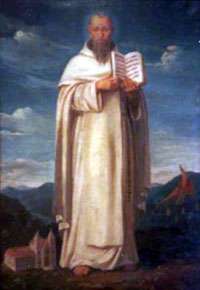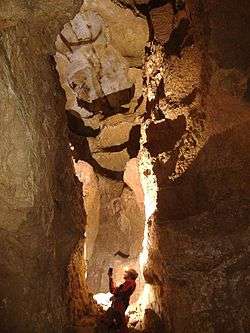Eusebius of Esztergom
| Blessed Eusebius of Esztergom | |
|---|---|
 Eusebius of Esztergom | |
| Priest | |
| Born |
ca. early 1200 Esztergom, Hungary |
| Died |
20 January 1270 Szentkereszt (today Pilisszentkereszt), Hungary |
| Venerated in | Roman Catholic Church |
| Beatified | 8 February 2009, Saint Peter's Square, Vatican City by Benedict XVI |
| Feast | 20 January |
| Attributes | Priest's attire |
| Patronage | Hermits |
Blessed Eusebius of Esztergom (Hungarian: Esztergomi Boldog Özséb, Polish: Euzebiusz z Ostrzyhomia, German: Eusebius von Gran; Esztergom, Hungary ca. 1200 – Szentkereszt (today Pilisszentkereszt), Hungary, 20 January 1270) was a Hungarian canon, hermit and the founder of the Order of Saint Paul the First Hermit.
Life
Early years
He was born in the early 1200s in Esztergom, Esztergom County, Hungary. According to Gergely Gyöngyösi's book The life of the hermit brothers of I Saint Paul the Hermit (Vitae fratrum Eremitarum Ordinis Sancti Pauli Primi Eremitae, 1496) Eusebius came from a well-known Hungarian family. Cécile Tormay states that Eusebius was a relative of the royal family of the Hungarian Kingdom. It can be found in other sources that he was the son of the granger of the royal court.[1]
Already in his childhood, he had shown his deep religious faith and his excellent ability to learn. He spent a lot of time praying and contemplating. He studied in the Seminar of Esztergom to become a priest. Later for his merits, he was named canon in Esztergom County.[2] In his spare time he wrote books. Even the names of these books did not survive. But according to Gergely Gyöngyösi these works were written in canon law.
At that time he was often visited by hermits from the Pilis Mountains who sold him wattled baskets in exchange for bread. Eusebius also visited them personally several times. The life of these hermits aroused his interest and he desired to become a hermit.[3]
Hermit life

Three years after the Mongol invasion of Europe he asked his bishop, Stephen I Báncsa for permission to leave his profession to become a hermit. Conscious sacrifice led him to hermitage. He settled in a cave north of Pilisszántó. He placed a large wooden cross in front of the entrance of his cave where he prayed and did his contemplations.[4]
One night during prayer he saw in the whole Pilis Mountains deep in the forest lots of tiny flames which moved towards him and they joined near his cross forming a huge fire flame. From the cross he heard voices:
"Eusebius, collect all the hermits in a loving community!"
His vision was followed by the founding of the first Hungarian founded order in 1250 which later became the Order of Saint Paul the First Hermit. He with his companion hermits erected their first monastery in honor of the Saint Cross and its church next to the cave.
At that time there were several hermit communities in Hungary who lived disorganized away from the society. Eusebius became their priest, and as a well-educated, canon law expert became their leader.
He then started to travel around the country to find other hermit communities. His first route led him to the hermits of Jakab-hegy, Baranya County who lived since 1225 there according to the Regula of Bartholomew le Gros, the Bishop of Pécs. The two monasteries united and the hermits have chosen Eusebius as the head of the order. Paul of Thebes became their patron. They called themselves the Brothers of I Saint Paul the Hermit. Their other name was the Brothers of the Saint Cross from the name of their first monastery.
Many people joined his order by adopting his strict rules. Their parents and friends tried to dissuade them, but Eusebius said to them:
"Christ loved his mother very much, but with his suffering his mother was tormented by the pain of his pain. He could have got off the cross, but he did not do it because he had fulfilled the will of his Heavenly Father. Likewise, we do not want to get off the cross of penance because people cry for us."
— Eusebius of Esztergom
On the 1256 National Council of Esztergom, he already wrote his name as the First Provincial of the Order of Saint Paul the First Hermit. In 1262 he went to Rome with his companions to meet Pope Urban IV to ask him for approval for founding his own order. Thomas Aquinas and Stephen I Báncsa helped him to reach his goals. The pope first refused to give Eusebius his permission because of financial conditions and asked Paul II, the Bishop of Veszprém to examine the function of the monasteries. After that, the pope allowed the operation.[5]
Already in his life there were 16 monasteries of his order. Later this number reached 150.
He was for 20 years provincial of the order.
Death
As he felt that his death is near he collected his companions around him, blessed them and died calm on the 20 January 1270.
Gallery
 Blessed Eusebius of Esztergom by Éva Vargha (1930s)
Blessed Eusebius of Esztergom by Éva Vargha (1930s) Engraving plate with blessed Eusebius of Esztergom by Hoffmann (18th century)
Engraving plate with blessed Eusebius of Esztergom by Hoffmann (18th century) Entrance hall of the cave of Eusebius
Entrance hall of the cave of Eusebius Entrance hall of the cave of Eusebius
Entrance hall of the cave of Eusebius
See also
Literature
- Gergely Gyöngyösi - The life of the hermit brothers of I Saint Paul the Hermit (Vitae fratrum Eremitarum Ordinis Sancti Pauli Primi Eremitae) 1496[6]
References
- ↑ http://www.rubicon.hu/magyar/oldalak/1270_januar_20_meghal_boldog_ozseb_a_palos_rend_megalapitoja/ - 1270. január 20. - Tamás M Tarján - Meghal Boldog Özséb, a pálos rend megalapítója
- ↑ "Boldog Özséb élete". Boldogozseb.hu. Retrieved 2017-09-26.
- ↑
- ↑
- ↑
- ↑ http://paulinefathers.org.au/about/blessed-eusebius/life-eusebius/ - Extracts from Vitae fratrum Eremitarum Ordinis Sancti Pauli Primi Eremitae by Gergely Gyöngyösi